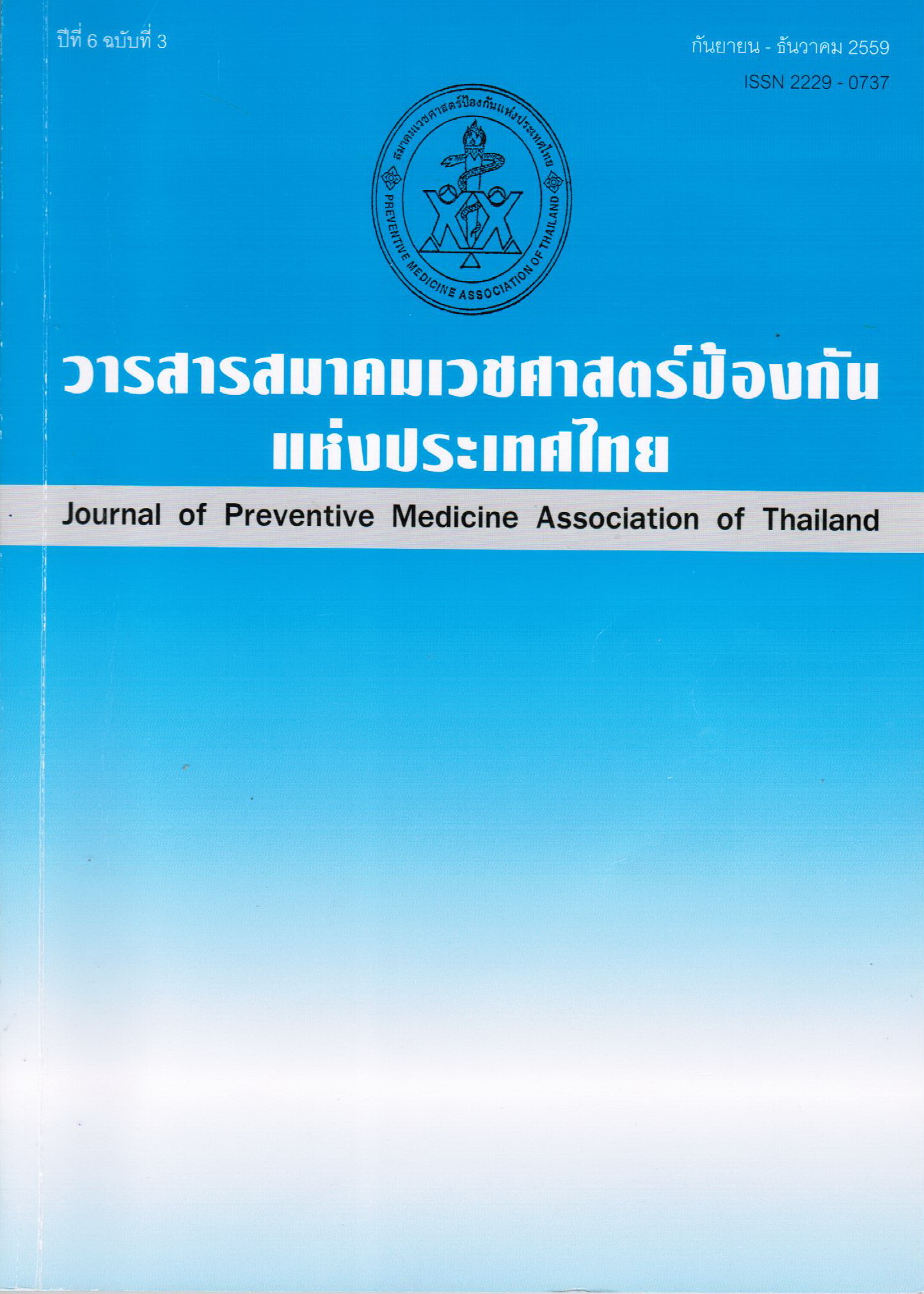The Effect of Food Control Program for Chronic Kidney Disease Patients at CKD Clinic, Phra Nakhon Si Ayutthaya Hospital
Keywords:
food control program for chronic kidney disease patients, food control behaviorAbstract
This quasi-experimental research was aimed to study the effect of food control program for chronic kidney disease patients at CKD clinic, Phra Nakhon Si Ayutthaya Hospital by applying the theories of self-efficacy. The samples were composed of 33 chronic kidney disease patients that were treated at CKD clinic, Phra Nakhon Si Ayutthaya Hospital. All participants completed the activity in 3 times. The questionnaires of characteristics, perceived self-efficacy in food control, and outcome expectations of food control and food control behavior were used for collecting data. Data were analyzed by using descriptive statistics and Paired t-test.
The research showed the most of the sample were male 51.5%, age 61-70 years old 45.5%, averageage 67.42 years, highest education level at primary school level 81.1%, no occupation 81.1%, average monthly income of less than 1,000 Baht 69.7%. Health status: most of the sample have hypertension 42.4% and stage 4 chronic kidney disease 63.6%. The research results revealed that after the intervention, the experimental group was significantly higher perceived self-efficacy in food control, outcome expectations of food control and food control behavior than before the intervention (p<0.001). After the intervention, the experimental group was no difference in Cr and eGFR before the intervention.
In conclusion, food control program for chronic kidney disease patients at CKD clinic, Phra Nakhon Si Ayutthaya Hospital was found to be effective in changing perceived self-efficacy in food control, outcome expectations of food control and food control behavior. As a result, the Cr and eGFR unchanged. This intervention should be continued and expanded in another community. The application to fit the context of each community.
References
2. Coresh J, Selvin E, Stevens LA, Manzi J, Kusek JW, Eggers P, Van Lente F, Levey AS. et al. Prevalence of chronic kidney disease in the United States. JAMA 2007; Nov
7: 298(17): 2038-47.
3. Ingsathit A, Thakkinstian A, Chaiprasert A, Sangthawan P, Gojaseni P, Kiattisunthorn K, Ongaiyooth L. et al. Prevalence and risk factors of chronic kidney disease in the Thai adult population: Thai SEEK study Group. Nephrol Dial Transplant 2010; May; 25(5): 1567-75.
4. รสสุคนธ์ วาริทสกุล. การจัดการอาหารเพื่อชะลอความเสื่อมของไตในผู้ป่วยโรคไตเรื้อรังจากเบาหวาน. วารสารพยาบาลทหารบก 2557;15(1):22-8.
5. สำนักงานปลัดกระทรวงสาธารณสุข สำานักนโยบายและยุทธศาสตร์. สถิติสาธารณสุข พ.ศ. 2556: Public Health Statistics 2013. กรุงเทพฯ: โรงพิมพ์องค์การสงเคราะห์ทหารผ่านศึก. 2557.
6. Pugh-Clarke K, Naish PF, Mercer TM. Quality of life in chronic kidney disease. J Ren Care. 2006; 32: 167-71.
7. มณีรัตน์ จิรัปปภา. การชะลอไตเสื่อมจากวัยผู้ใหญ่ถึงวัยผู้สูงอายุ. วารสารวิทยาลัยพยาบาลบรมราชชนนี นครราชสีมา 2557; 20(2): 5-16.
8. สุนิสา สีผม. การจัดการตนเองในผู้ป่วยโรคไตเรื้อรัง. วารสารการพยาบาลสภากาชาดไทย 2556; 6(1): 12-8.
9. โรงพยาบาลพระนครศรีอยุธยา คลินิกชะลอไตเสื่อม (CKD). รายงานสถิติผู้ป่วยที่มารับการรักษาที่คลินิกชะลอไตเสื่อม (CKD) โรงพยาบาลพระนครศรีอยุธยา ปี พ.ศ. 2557-2558. (เอกสารสำเนา). พระนครศรีอยุธยา: โรงพยาบาลพระนครศรีอยุธยา. 2558.
10. สุกาญจน์ อยู่คง, มณี สมภพเจริญ, ธราดล เก่งการพานิช และทัศนีย์ รวิวรกุล. ผลของโปรแกรมการกำากับตนเองต่อพฤติกรรมการควบคุมอาหารในผู้ป่วยเบาหวานชนิดที่ 2. เอกสารประกอบการประชุมสุขศึกษาแห่งชาติ ครั้งที่ 17 เรื่องบทบาทของประชาชนกับการปรับเปลี่ยนพฤติกรรมสุขภาพ. 14-16 พฤษภาคม 2558; ณ โรงแรมจอมเทียน ปาล์มบีช โฮเต็ล แอน รีสอร์ท เมืองพัทยา จังหวัดชลบุรี. ชลบุรี. 2558: 272-85.
11. ฉลอง สีแก้วสิ่ว. การกำาหนดขนาดสิ่งตัวอย่างในการทดสอบสมมติฐาน (Sample size selection). ใน Statistic [ออนไลน์]. 2555 [วันที่ค้นข้อมูล 22 พฤศจิกายน 2558]. แหล่งข้อมูล:URL: https://sites.google.com/site/mystatistics01/chapter4/sample-size-selection./
12. สมาคมโรคไตแห่งประเทศไทย และสำานักงานหลักประกันสุขภาพแห่งชาติ. คู่มือการจัดการดูแลผู้ป่วยโรคไตเรื้อรังระยะเริ่มต้น. กรุงเทพมหานคร: บริษัท ยูเนียนอุลตร้าไวโอเร็ต จำกัด. 2555.
13. Bandura, A. Self-efficacy: Toward a unifying theory of behavioral change. Psychological Review 1977; Mar; 84(2): 191-215.
14. Bandura, A. Self-efficacy Mechanism in Human Agency. American Psychologist1982;Feb:37 (2): 122-47.
15. ประณีต สิงห์ทอง. โปรแกรมส่งเสริมความสามารถตนเองในการปรับเปลี่ยนพฤติกรรมของบุคลากรกลุ่มป่วย โรคเบาหวาน โรคความดันโลหิตสูง โรงพยาบาลเจ้าพระยายมราช. วารสารสุขศึกษา 2557; 37(126): 35-48.
16. ภัทรานุช พิทักษา และคณะ. ผลของโปรแกรมสุขศึกษาในการปรับเปลี่ยนพฤติกรรมการรับประทานอาหารในนักเรียนชั้นประถมศึกษาปีที่ 6 จังหวัดบุรีรัมย์. วารสารสุขศึกษา 2557; 37(126): 66-81.
17. ศนีชา วิเดช. ประสิทธิผลโปรแกรมสุขศึกษาโดยประยุกต์ทฤษฎีความสามารถแห่งตนต่อพฤติกรรมสุขภาพของนักเรียนที่มีน้ำาหนักตัวเกินมาตรฐาน. (วิทยานิพนธ์ปริญญาวิทยาศาสตรมหาบัณฑิต). สุขศึกษา. บัณฑิตวิทยาลัย. กรุงเทพฯ: มหาวิทยาลัยศรีนครินทรวิโรฒ. 2554.
18. ภทรพรรณ อุณาภาค และขวัญชัย รัตนมณี. ปัจจัยที่มีความสัมพันธ์กับพฤติกรรมการดูแลตนเองเพื่อป้องกันภาวะแทรกซ้อนทางไตในผู้ป่วยโรคไตเรื้อรังของโรงพยาบาลสมเด็จพระพุทธเลิศหล้า จังหวัดสมุทรสงคราม. วารสารสาธารณสุขมหาวิทยาลัยบูรพา 2558; 10(2): 44-54.
Downloads
Published
How to Cite
Issue
Section
License
บทความที่ลงพิมพ์ในวารสารเวชศาสตร์ป้องกันแห่งประเทศไทย ถือเป็นผลงานวิชาการ งานวิจัย วิเคราะห์ วิจารณ์ เป็นความเห็นส่วนตัวของผู้นิพนธ์ กองบรรณาธิการไม่จำเป็นต้องเห็นด้วยเสมอไปและผู้นิพนธ์จะต้องรับผิดชอบต่อบทความของตนเอง






